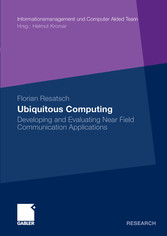Search and Find
Service
More of the content

Ubiquitous Computing - Developing and Evaluating Near Field Communication Applications
3 Human Computer Interaction and Technology Acceptance (p. 46-47)
The focus of this chapter is to state the basic requirements of NFC-based applications relative to human-computer interaction theory (Chapter 3.1). It also seeks to further integrate the technology acceptance models to be applied into the Ubicomp setting (Chapter 3.2).
3.1 Human Computer Interaction
The connection between human computer interaction (HCI) and Ubicomp was discussed from Ubicomp’s early stages up to today (Abowd 1996; Abowd/Atkeson/Essa 1998; Abowd et al. 1998; Abowd/Mynatt/Rodden 2002). Abowd also discussed the effects of prototypes in the area of Ubicomp to facilitate technology diffusion (Abowd et al. 2005). Interfaces of various kinds were discussed intensely in Ubicomp literature—especially because the use of haptic elements, such as RFID chips, changes the established forms of interaction familiar from desktop computers (Henseler 2001; Michelis et al. 2005; Poupyrev/Okabe/Maruyama 2004; Ishii/Ullmer 1997; Blackler/Popovic/Mahar 2003; Öquist 2006; Thevenin/Coutaz 1999; Ballagas et al. 2003; Tan 2000; Shneiderman 1992; Raskin 2000; Mantyjarvi et al. 2006; Välkkynen et al. 2003).
Only few of the known literature approaches discuss the effects of everyday activities and principles associated with routine tasks, although these effects were part of the Ubicomp vision and are relevant for building systems that will be accepted by users (Mattern 2003b, 2003c, 2005b; McCullough 2004; Weiser 1993).
Human beings have one thing in common: an everyday life and the range of actions that life encompasses. The Ubicomp definition presented included applications within the everyday action range of human beings (see section 2.1.1). This everyday life is determined by several factors that loop back to the development of—and the interaction with—Ubicomp applications.
Ubicomp use is quite different from desktop computer use. Daily life centers around activity spaces (Golledge/Stimson 1997) within specific contexts. With a link from the virtual into the physical world, an interaction design off the desktop becomes essential (McCullough 2004; Norman 1988). Ubicomp applications should function only when we want them to and in a way in which we do not need to know how they function.
These “information appliances” (Norman 1999b, 53) allow people to carry out tasks without needing to be aware of the computers that are involved (McCullough 2004). Simplicity, as already stated, is the primary motivation driving the design of information appliances. Design the tool to fit so well that it becomes a part of the task (Norman 1999b, 53). This design credo describes a way of creating computers so that they are invisible to us perceptually, i.e. so that we are not conscious of them.
Human Computer Interaction (HCI) is defined as “a discipline concerned with the design, evaluation and implementation of interactive computing systems for human use and with the study of major phenomena surrounding them.” The focus is “specifically on interaction between one or more humans and one or more computational machines”, which together form an adequate context for Ubicomp (Hewett et al. 1992). HCI has two sides, both the machine and the human side, connected via an interface. An interface can exist in different ways. Raskin gives a broad definition: “The way that you accomplish tasks with a product—what you do and how it responds” (Raskin 2000).
All prices incl. VAT












